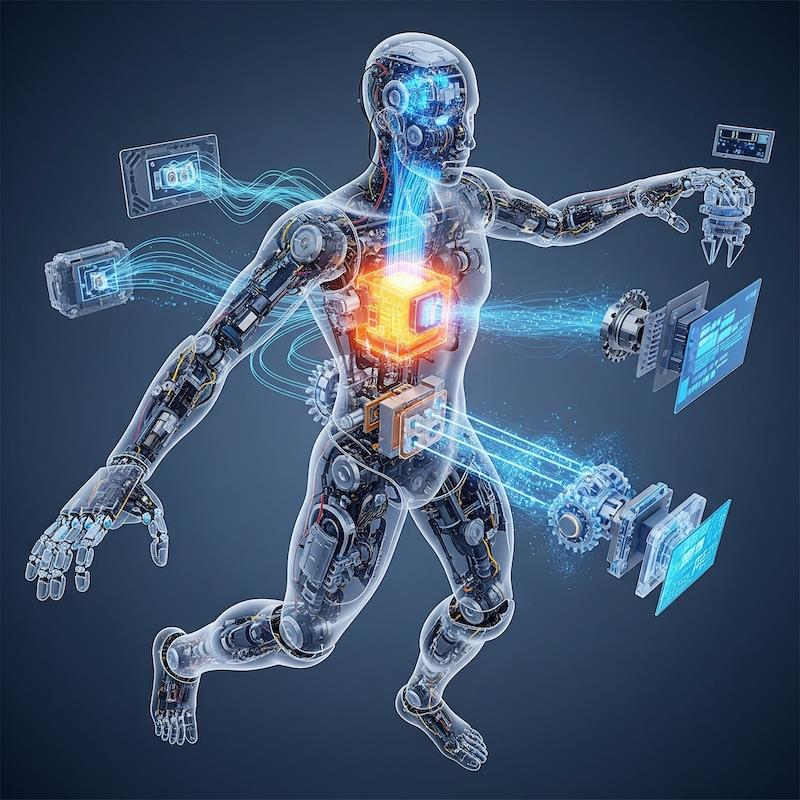
How Do Robots Work? A Breakdown Of Sensors, Controllers, Actuators And Software
July 1, 2025 by Sam Francis
This article is part of a series of articles based on common questions in robotics. The previous article dealt with the question: What is a robot?
Robots are machines designed to perform tasks – ranging from simple, repetitive actions to complex decision-making processes. But how do they actually work?
At the most basic level, every robot operates through a combination of four core components: sensors, controllers, actuators, and software. These systems work together, often in a closed feedback loop, to carry out programmed instructions and respond to the environment in real time.
Sensors: Robots perceive the worldJust like humans rely on their senses, robots use sensors to gather information about their surroundings and their own internal state. These sensors can measure:
-
Distance and proximity (lidar, ultrasonic sensors)
Force and torque (pressure sensors in robotic grippers)
Vision (cameras, infrared sensors)
Orientation and position (gyroscopes, GPS, encoders)
Environmental factors (temperature, light, chemical presence)
Without sensors, a robot would be effectively blind and deaf – incapable of adjusting to changes or operating autonomously.
Controllers: The robot's brainThe controller acts as the robot's central processing unit. It receives data from the sensors, processes that information according to pre-written code or algorithms, and sends commands to the actuators.
This control system may be:
-
A simple microcontroller (like those in toy robots)
A programmable logic controller (PLC) used in industrial settings
A high-performance embedded computer running advanced AI software
In modern systems, especially those involving autonomous navigation or manipulation, controllers may also include neural networks or machine learning models to interpret sensor data and make decisions.
Actuators: Moving the robotActuators are the components that produce movement or force. They are the“muscles” of the robot, executing the commands issued by the controller.
There are several types of actuators, including:
-
Electric motors (servo motors for precise movement)
Hydraulic cylinders (used for heavy-duty lifting)
Pneumatic systems (air-driven motion, fast and responsive)
Soft actuators (flexible and often used in bio-inspired robots)
Depending on the design, actuators may drive wheels, rotate arms, open grippers, or even power walking and flying mechanisms.
Software: Programming behaviorRobots follow instructions written in software. This can range from basic, linear scripts to complex, adaptive programs that learn over time. The software determines how sensor input is interpreted, how the controller responds, and what actions the actuators take.
Software also enables:
-
Motion planning (deciding how to move from point A to B)
Pathfinding (for mobile robots navigating an environment)
Collision avoidance
Object recognition
Human interaction (speech recognition, gesture interpretation)
In many modern robots, software is updated regularly and can even be trained using machine learning, allowing the robot to improve performance through experience.
A simple feedback loopThe operation of a robot can often be described as a feedback loop:
-
Sense: Sensors detect input.
Process: The controller interprets the input.
Act: Actuators carry out the response.
Repeat: New sensor input is gathered to adjust the next action.
This loop may run dozens or thousands of times per second, allowing robots to perform tasks like welding, picking objects off a conveyor, or navigating an obstacle course with remarkable speed and precision.
Beyond the basics: Autonomy and AIWhile many robots operate in structured environments with repetitive tasks (like manufacturing), more advanced robots integrate AI to handle unstructured, dynamic settings – such as autonomous vehicles, delivery drones, and social robots.
These systems require:
-
Advanced perception (combining multiple sensor streams)
Real-time decision-making
Adaptive control systems
AI-powered robots are capable of tasks that used to be exclusive to humans – like playing football, performing surgery, or assisting elderly people in their homes.
Vital rolesAt their core, all robots work by integrating sensors, controllers, actuators, and software. Each part plays a vital role in transforming a machine into a responsive, purposeful system.
Whether it's a robotic vacuum cleaner or a warehouse automation arm, the same basic principles apply. The difference lies in how sophisticated the integration and programming are.
As robotics continues to evolve, the synergy between these core components – and the addition of AI – will only deepen, enabling machines to take on an ever-expanding range of human and superhuman tasks.
Legal Disclaimer:
MENAFN provides the
information “as is” without warranty of any kind. We do not accept
any responsibility or liability for the accuracy, content, images,
videos, licenses, completeness, legality, or reliability of the information
contained in this article. If you have any complaints or copyright
issues related to this article, kindly contact the provider above.


















Comments
No comment